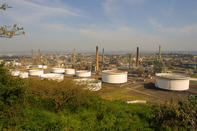Mass Burning of Fossil Fuels

The mass burning of fossil fuels started in the mid-1700s, but it was mostly coal that pulled side by side with wood in the harness of industrialisation. It was only towards the 1850s that commercial exploitation of oil wells began. By 1910, oil still only accounted for five per cent of the world's energy supply. It took a boom in the vehicle industry in the 1930s before oil streaked ahead of wood and coal in the energy race.
Soon the industrial world's demand for oil reshaped global geopolitics. This heralded the rise of the hydrocarbon economy and, by the end of the twentieth century, 90 per cent of energy used globally came from fossil fuels.
Developed countries since became increasingly dependent on cheap oil to fuel their heavily industrialised economies. Continued growth and the comfortable lifestyles of First World electorates were dependent on their country's ability to find cheap oil.
‘The End of Oil’ author Paul Roberts says this scenario played itself out under an entirely new set of global rules with government foreign policy and oil companies manipulating global oil markets: In a remarkably short time, oil had moved to the very epicentre of geopolitics.
Just as nineteenth-century imperial powers had competed for the colonies with the best sugar and tea and slaves, the industrial powers of the twentieth century manoeuvred for the choicest oil regions.
Driven by the ravenous demand for oil, Western governments and their able assistants, the international oil companies, vied for control over the hapless oil states of Venezuela, Mexico, Sumatra, Borneo, and especially the Middle East, where European and United States diplomats redrew the map to maximise access to oil. As one French diplomat declared during a period of particularly frenzied boundary drawing, 'He who owns the oil will own the world'.